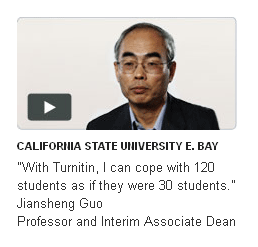We Shape Technologies / Technologies Shape Us
Despite the complexity of responding to a seemingly simple concept like plagiarism, Turnitin has long attempted to resist dominant narratives of plagiarism and present itself instrumentally, a neutral tool for determining unoriginality in a written work. One way it attempts to showcase its supposed neutrality is by arguing that its “originality report” (a color-coded depiction of material on a spectrum of originality, wherein blue is original; green, yellow, and orange are possibly and increasingly unoriginal; and red is highly unoriginal) simply matches text against other text to see what matches:
The service does not detect nor determine plagiarism–it detects patterns of matching text to help instructors determine if plagiarism has occurred. Indeed, the text in the student’s paper that is found to match a source may be properly cited and attributed. It is recommended that instructors carefully review the Originality Report and all matches before making any determination of plagiarism. Such determinations of plagiarism require human judgment, and instructors and students alike should understand their institution’s academic integrity policies before turning in written assignments. (“Plagiarism and the Web,” p. 5).
 However, this depiction of Turnitin as a technology that merely matches text and reports on its level of originality is at odds with popular depictions of plagiarism detection services, illustrating the necessity of a critical approach to this technology. I would argue as well that its message of neutrality is at odds with its predominant message of ease of use; that is to say, if the site promises ideals like “cop[ing] with 120 students as if they were 30” and becoming “at least 60-70% faster with [your] grading,” these ideals take time (“Turnitin: College and University,” 2012; “Turnitin: Middle and High School,” 2012). If the technology indeed assists instructors in faster, more efficient writing response, then the technology is not neutral; it clearly has been programmed in response to the values of its intended audience. Is what we strive for in our teaching the ability to become faster, more efficient? Is it the ability to "cope" with students? Is it getting grading out of the way as quickly as possible? These are the unspoken values that Turnitin's claims speak to directly, and these are values that have emerged within an ideology that upholds efficiency and profitability in the university, and privileges hierarchical differences between students and instructors in the classroom. This emphasis on efficiency, Feenberg (2005) reminded us, is the difference between successful and failed technologies in determinist and instrumentalist accounts of technology (p. 51). But efficiency itself is relative to socially desirable objectives, here coded as coping with students through grading and feedback rather than building relationships with developing researchers.
However, this depiction of Turnitin as a technology that merely matches text and reports on its level of originality is at odds with popular depictions of plagiarism detection services, illustrating the necessity of a critical approach to this technology. I would argue as well that its message of neutrality is at odds with its predominant message of ease of use; that is to say, if the site promises ideals like “cop[ing] with 120 students as if they were 30” and becoming “at least 60-70% faster with [your] grading,” these ideals take time (“Turnitin: College and University,” 2012; “Turnitin: Middle and High School,” 2012). If the technology indeed assists instructors in faster, more efficient writing response, then the technology is not neutral; it clearly has been programmed in response to the values of its intended audience. Is what we strive for in our teaching the ability to become faster, more efficient? Is it the ability to "cope" with students? Is it getting grading out of the way as quickly as possible? These are the unspoken values that Turnitin's claims speak to directly, and these are values that have emerged within an ideology that upholds efficiency and profitability in the university, and privileges hierarchical differences between students and instructors in the classroom. This emphasis on efficiency, Feenberg (2005) reminded us, is the difference between successful and failed technologies in determinist and instrumentalist accounts of technology (p. 51). But efficiency itself is relative to socially desirable objectives, here coded as coping with students through grading and feedback rather than building relationships with developing researchers.
Similarly, how can the technology both objectively detect matching patterns while at the same time offer a product that allows for drastically improved grading, feedback, and coping with teaching, the latter being value-laden claims?  These messages seem contradictory. James Purdy (2009) described the tensions inherent in the system and its marketing: “Qualitative interpretation is required to determine if a text has been plagiarized … Someone who uses these services as the fast checks for plagiarism that they are advertised to be, therefore, can misjudge work. When used as marketed … these services do not allow for the qualitative interpretation that they admit is crucial to labeling work as plagiarized” (p. 70). It is somewhat ironic that one video testimonial of Turnitin.com describes the service as doing something no human can do. In fact, it is necessary for a human to interpret the originality report, to facilitate the peer review, to connect with the students in the classroom. Technologies like Turnitin are dependent on us to make them meaningful, and indeed, to decide whether or not to use them at all. Despite the language of intent, the use of Turnitin—and the attendant change in attitudes about plagiarism and original work—is what is crucial.
These messages seem contradictory. James Purdy (2009) described the tensions inherent in the system and its marketing: “Qualitative interpretation is required to determine if a text has been plagiarized … Someone who uses these services as the fast checks for plagiarism that they are advertised to be, therefore, can misjudge work. When used as marketed … these services do not allow for the qualitative interpretation that they admit is crucial to labeling work as plagiarized” (p. 70). It is somewhat ironic that one video testimonial of Turnitin.com describes the service as doing something no human can do. In fact, it is necessary for a human to interpret the originality report, to facilitate the peer review, to connect with the students in the classroom. Technologies like Turnitin are dependent on us to make them meaningful, and indeed, to decide whether or not to use them at all. Despite the language of intent, the use of Turnitin—and the attendant change in attitudes about plagiarism and original work—is what is crucial.
index ![]()
![]() the specter of internet plagiarism
the specter of internet plagiarism ![]()
![]() the turn to turnitin.com page 1
the turn to turnitin.com page 1 ![]() page 2
page 2 ![]() page 3
page 3 ![]() page 4
page 4 ![]() page 5
page 5 ![]() page 6
page 6 ![]()
![]() authorship and anxiety page 1
authorship and anxiety page 1 ![]() page 2
page 2 ![]() page 3
page 3 ![]() page 4
page 4 ![]() page 5
page 5 ![]() page 6
page 6 ![]()
![]() critical assessment
critical assessment ![]()
![]() references
references

